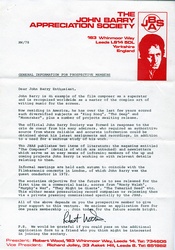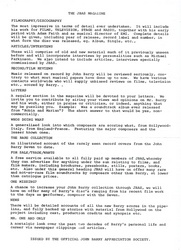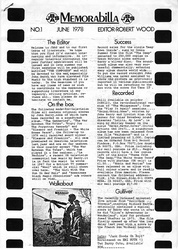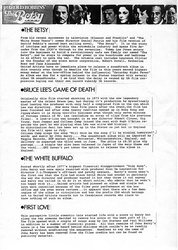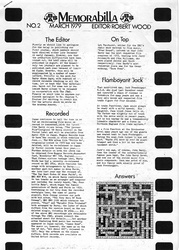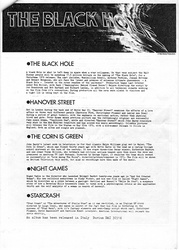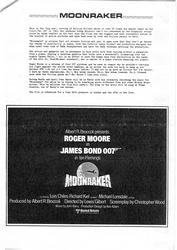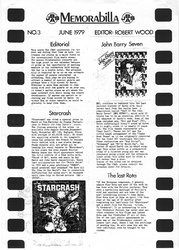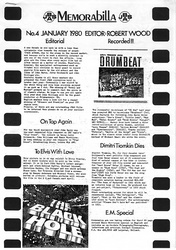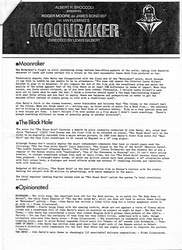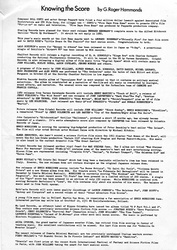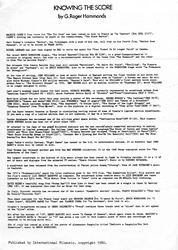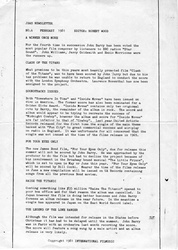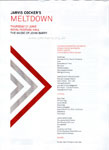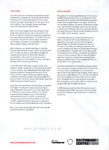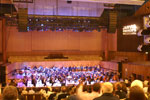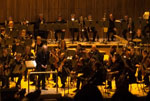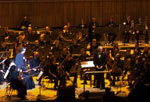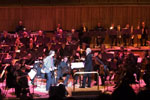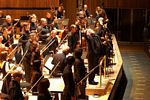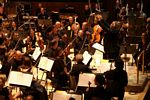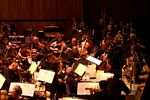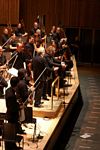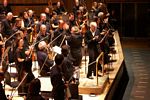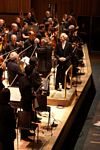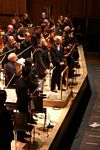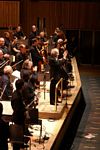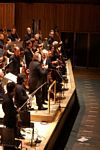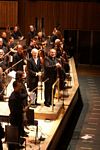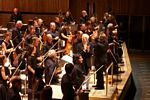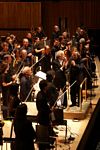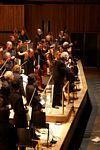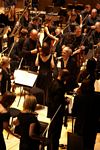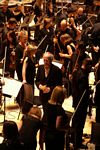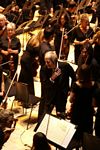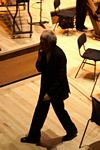
Webmaster
In Memoriam John Barry
Ron Curry, MBE
February 3, 2011
I am glad to have this opportunity to express my great admiration and respect for John Barry's music scores.
I first met Mr Barry at C T S Studios, Bayswater, London in December 1971 when he was scoring Sir Carol Reed's "Follow Me". To my mind there were two John Barrys, the Composer and the Conductor, each culminating in musical style. The work starting from subject matter, a film in rough cut after plotting musical cues with the then director and editor, the weeks and sometimes months of isolation when composing for a project, pulling the elements together however diverse, following his instincts being stylistic as only he could do it to "get a fix" from the blank manuscript paper. The work structured with musical intentions, the character of the writing of the music trenchancy and direction of the scoring and cross referencing, building layer upon layer of musical textures creating complex sounds all starting as dots on paper.
As if game-like, notation written with the help of a metronome and a stopwatch, musical colours exchanged from one instrument to another to be given a new life as it fades to be picked up by another musical bridge, to grow and then fade in spacious lyricism using his musicianship and interpretative imagination to bring his written "cues" to fit the confines of time restrictions.
Writing from one chord to another almost key changing. The melody staying in the logical sense but changes are happening like undercurrents taking the music into another mode his perfection of attach and clarity of harmonies and tone.
His feelings and moods, the theme and variations in his music are written structurally for film sequences, a score full of thematic motifs which can still retain its value as music when presented as a separate form. Divorced from the film.
His impact and depth of emotion with feeling not sentimentality for both orchestra and voices, for a non film work (The Beyondness of Things) using his own random thoughts for the function of the music.
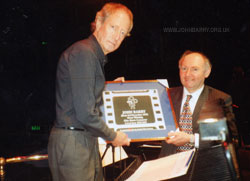 To enrich the music was John Barry the Conductor. Mr. Barry always conducted his own work. Watching Mr Barry conduct in recording sessions, his body swaying, his baton jabbing and coaxing, this was the fun of the game for him. To finally stand in a Studio and conduct his finished score with the detail and subtleties that only he could give his music.
To enrich the music was John Barry the Conductor. Mr. Barry always conducted his own work. Watching Mr Barry conduct in recording sessions, his body swaying, his baton jabbing and coaxing, this was the fun of the game for him. To finally stand in a Studio and conduct his finished score with the detail and subtleties that only he could give his music.
Thank you for the music John.
© Ron Curry MBE
Photo attachment: Centenial of British Film Commerative copy plaque being presented by Ron Curry to John Barry, Royal Albert Hall, Saturday 18th April, 1998.
John Barry remembered
Peter Stanhope
February 3, 2011
You may not know the man, but you will almost certainly know his music.
John Barry OBE, a Honorary Freeman of York, is being remembered worldwide following his recent death at 77 yrs.
I feel very fortunate in that I did meet the man, when both of us were quite young, and I have adored his music from so many award winning films.
I came to first know John Barry Prendergast when I used to hang around back-stage at the Rialto cinema in York in the late 1950's during Sunday concerts on the stage. These shows starred some of the biggest names in music at that time, from jazz to skiffle, from big bands to individual singers. Lonnie Donegan, Count Basie, Lionel Hampton, Chris Barber, Dickie Valentine, Sarah Vaughan and, yes, even the Beatles - all performed on the stage at the Rialto.
Back-stage Barry (as we called him) used to regale the arriving audience with his favourite music played over the PA system from a turntable with LP's behind the stage curtains. His favourites were Stan Kenton - then a major American big-band - as he had studied through a correspondence course with Bill Russo, a trombonist with this band.
I was there taking photographs of all the stars for my own interest and personal collection. As a late teenager I had the run of the whole cinema, by kind permission of Barry's father, Jack Xavier Prendergast who owned it. I met and photographed all those greats and had a wonderful time most Sunday evenings.
At a time in the late 50's Barry decided to start his own rock band - the John Barry Seven - and his father asked me if I would take some photos of them for 'front of house' pictures. So I was the first person to photograph the John Barry Seven before they went on to success and other London photographers.
Over the years, as history tells, the John Barry Seven gave way to John Barry the movie composer after having first been asked to 'rework' Monty Normans original James Bond theme tune. That lead to other film music being scored for a whole series of Bond movies and then many other Hollywood and British block-busters including Born Free, Dances with Wolves, Out of Africa, Chaplin and many more. Wonderful music - almost classical, symphonic in its own way.
At the beginning of the new Millennium I got to meet up with Barry again, here in York. I had nominated him for the Honorary Freedom of the City of York. After doing battle with the City Fathers of the day (they were a lefty bunch back then which did not like 'honours') I eventually got them to bestow the Honorary Freedom of the City on Dr. John Barry OBE at a ceremony held in the Georgian Assembly Rooms. This was in June of 2002 and I and my wife Jean got to meet John again, and his wife Laurie, and had photos taken on that memorable occasion.
It was a great event for a great man and he was clearly humbled by the historic significance of the occasion.
A touch of irony was that the honour was bestowed on him by the Lord Mayor standing on the very same stage that Barry had sat on almost 50 years before as a young trumpeter playing in the dance band which used to play at the Assembly Rooms every Saturday - and that was where I had first asked Jean out to a dance in 1958 !
So the great man is gone but his great music will live on forever. I regard it as being a great honour to have known him, if only briefly, during his lifetime.
If you like John Barrys music I can recommend no better collection than his "Moviola" album which contains many of his most haunting and emotional film themes.
Peter Stanhope
The Cine-Tele Sound (CTS) Studios
Read article Read article on this website.
The BFI screening of Four in the Morning
Peter Greenhill
April 26, 2010
Capital Tales: Four in the Morning
The BFI screening of Four in the Morning
Wed 21 Apr. 2010, 18:20, NFT1
"Anthony Simmons' film, which plays like a L'Avventura of the Docklands."
Peter Greenhill saw 'Four In The Morning', the 1965 film directed by Anthony Simmons at BFI in London.
The film has three threads:
1) The river police picking up the body of a dead woman from the Thames.
2) A seemingly rootless young man (Brian Phelan) picks up a singer (Ann Lynn) he knows, after her work. At four in the morning they romp around the Thames' shores, steal a boat, leave it, almost touch each other emotionally but are they committed?
3) The other couple is shown as a woman (Judi Dench) waiting for her husband, (Norman Rodway) out on the town with a bachelor crony. The baby cries and exasperates her. The growing incompatibility of the couple is deftly outlined in bold, dramatic strokes...
The three threads are linked by London’s river. The film is bleak but is also absorbing and eminently watchable thanks to great performances, atmospheric photography and a haunting score by John Barry which is just perfect for the movie, underlining its sense of sadness and yearning with mournful oboes and sighing flutes.
There was a good turnout for the movie with BFI 1 almost full. The film was introduced by director/writer Anthony Simmons who also did a Q&A after the showing. Simmons said that he originally intended doing a documentary about London as he couldn’t find a suitable story. He then read a poem about a dead body in the river and the idea grew to make a film about London and its river. The screenplay was only partly written when shooting started. The Dench/ Rodway section was not written when Phelan and Lynn filmed their section.
In the end the film is really three short films combined into one. feature movie. It took 3-4 months to shoot. Judi Dench was not Simmons’ first choice for the role of the young wife/mother but he wouldn’t say who was.
Simmons said that John Barry was his first choice to do the score. He had previously worked with Barry on a couple of commercials. Barry was shown the film and loved it but Simmons had to tell him that there was little money. ‘No problem’ said Barry ‘I’ll get paid by the PRS, as long as you don’t want any royalties’. The interviewer pointed out that 1965 was a good year for Barry (Ipcress, Thunderball, Born Free etc) and that he could probably afford not to take a fee. Barry was definitely on a roll in 1965. Both the interviewer and Simmons agreed that Barry wrote a great score. The score, like the film, is underestimated but it certainly shows how Barry could ‘nail’ a movie so beautifully
Filming was not restricted to the early hours of the morning, sometimes cinematographer Larry Pizer would put black silk stockings over the lens and so there was an absence of black in the print which was consequently shades of grey.
The film played well in Europe and won several awards but had a limited release in the UK due to resistance by Rank. It was never released in US probably because it showed a London that wasn’t swinging.
The film is available on R2 DVD
and the score available at:
http://www.amazon.co.uk/Zulu-Four-Morning-John-Barry/dp/B00002ZZ3G/ref=sr_1_1?ie=UTF8&s=music&qid=1272015165&sr=1-1
or
http://www.amazon.co.uk/Revisited-4-CD-Box-Set/dp/B002OM628Q/ref=sr_1_1?ie=UTF8&qid=1272015255&sr=1-1-spell
as well as other retailers.
John Barry Appreciation Society, Leeds - old newsletters / 'memorabilla' 1978 - 1981
Geoff Leonard
April 14, 2010
With the recent sad demise of Movie Boulevard, run by Robert Wood & Richard Jolley for many years, we thought visitors to this site might be interested to see the newsletters issued as part of the John Barry Appreciation Society, which preceded the mail-order business and shop.
Obviously some of the news subsequently turned out not to be correct but bear in mind this was well before the internet and for many it was the *only* way of getting any news about John Barry.
Courtesy scans: Gareth Bramley
Copyright: International Filmusic (1978 - 1981).
|
|
|
|
|
|
|
|
John Barry at Abbey Road Studios
Geoff Leonard
January 19, 2010
According to the list prepared by Vic Lanza when he was compiling the John Barry – The EMI Years series, some tracks remain unreleased.
However, it’s possible they were retitled and released as were some in the following list.
Some comments:
Interesting to see the Moonraker track listed and also Man in the Middle.
The two A Matter of Who tracks are curious since they are much longer than the version that *was* released.
Little Old-fashioned Love & Throw All Your Lovin’ My way are both JB vocals. They were eventually recorded and released by Larry Page.
The “Michael Angelo” track was recorded a couple of weeks after Roman Spring/Tears.
Walk Don’t Run (Orchestra Only) is very odd. Orchestra on Walk Don’t Run?
- Care For Me, 21-11-1959, (unissued)
- Cat with a Fix (possibly retitled), 2’ 10”
- Dominica, (retitled Starfire)
- Bond Back in Action Again (Goldfinger)
- The Gun (retitled March of the Mandarins)
- If at First You Don’t Succeed (retitled Onward Christian Spacemen)
- Little old-fashioned Love
- Man in the Middle (not available to EMI)
- A Matter of WHO (fast), 3’ 12”
- A Matter of WHO (medium), 3’ 15”
- Miss Goodhead meets Bond (Moonraker)
- My Best Shoes, (same ref no. as Bees Knees – retitle?,) TL4713 No Go E36016 Box 377, 2’ 11”
- Rollin’ Along (retitled Rockin’ Already)
- String Beat, (possibly retitled), (July 31st 1961 - Starfire was recorded on this date)
- They’ll Make You Whistle, (must surely be Snap ‘n Whistle)
- Throw All Your Lovin’ My Way, 2’ 23”
- Untitled (Michael Angelo), 8 March 1962
- Wagon Train Box 300, 2’ 17”
- Walk Don’t Run (Orchestra Only)
- Whispering Your Name (no further details)
Sketch of Main Title to The Dove
December 11, 2009
By Terry Walstrom
I shall attempt a sort of free sketch of Main Title to The Dove without bogging down in sordid details the non-musician might find soporific.
John Barry prefers (if past choices are to be an indication) minor key melodies. Minor keys are the brooding, mysterious and sad ones. He also has a tendency to select the key of F for his major melodies and Fminor, Eminor or Cminor for his other venues.
The Dove is an exception The key is plain vanilla C Major. Look at your local piano. See those white keys? Yep, that's C major.
It is what we like to call the guitarist's favorite key. As an aside, George Gershwin would/could only play in C major. I guess those glissandos are easier that way:) (A glissando is a sweep up or down hitting all the notes in a scale.)
Barry's choices for what instruments are going to play his theme are unusual (for him.)
Normally, JB uses the guitar either for melody (James Bond theme) or for rhythm/percussive effect. The Big Band era used acoustic guitars for rhythm purposes and the jazz era developed a sort of strum and "fill" style that created an effective color. But, not until the invention of the electric guitar (so you could actually HEAR the notes) did the guitar come crashing to the front of the line.
In The Dove, Barry has chosen for the guitar something completely unusual. An arpeggio/rhythm. There are twin 12 string guitars (they sound like that timbre, but, I suppose they might simply be gutstring) creating a rather loud arpeggio in triplets (three notes cycling over and over) on both wings of the listener's field of aural soundscape. In other words: far left and far right.
Why? We might well ask. I can't say. From a musical standpoint, nobody else did it before and it seems to work. Is that good enough? :)
It has a rough texture that catches the ear and puts some "grit" in the mix. Further, it has a psychological motive. The guitar is not a "formal" instrument. It is portable. It represents the vagabond, the adventurer out and about. Otherwise, your conservatory brand composer would have placed a HARP here instead of the guitar. This choice is friendly to the ear and catches the spirit of a sailing spree by young people on an adventure. That's as much seat of the pants psychology as I can offer:)
Later, just for fun and contrast, I might go back and substitute different instruments in place of John Barry's and let you hear what a world of difference it makes to how you FEEL when listening.
In addition to the guitars, John Barry is going to play his melody theme on the violins as a section (not as a solo instrument) and will have the flutes playing the same notes. Musically, this is called "doubling". Barry's flute/violin section doubling gives a pure sound that is pretty without being corny.
Cumulatively, the bass notes will be plucked by the double bass (giant, fat, swollen-looking violins that stand upright:) as the low strings (always on the right) give us a carpet of---shall we say---additional rhythm, and provides a sweeping warmth to the mix.
For punctuation, the timpani (kettledrum) adds a bit of emphasis here and there. You can't have John Barry and not have Horns. Barry's singular use of horns is sui generis. He does it and nobody else does it like him. (I can't imagine why they don't, frankly!) The Horns, he discovered around 1965, can be used in a choir (three or more at once) the way the piano player uses chords or the guitar player uses chords. Not to say he didn't know this before. He didn't really use it and develop the horn choir until mid 60's. Great Movie Sounds of John Barry introduced our ears to this device. Listen to the track: From Russia with Love. The horns are clustered in the low register. It is turgid, muddy and almost unpleasant. This is a first effort. Later, Barry began putting the Horn Choir in the middle and high register to great effect. On Her Majesty's Secret Service unfurls the sweeping sonority of Brass Choir majesty in all its glory... But, I digress... In The Dove, the brass isn't used for beauty and majesty so much as it is for dramatic power and punctuation.
John Barry likes to double the strings, flute and marimba. A marimba is like a Xylophone or vibraphone, except the tone is precise and there is no after tone. In the Main Title's middle section the marimba "cuts through" the mix and gives definition to the rhythmic counter-melody in a way that neither strings nor flute can alone.
Further, if we subtract the melody content and expose the skeleton or spine of this composition we'll discover a sense of motion up and down the scale which is quite exhilarating in its energy and good-naturedness. The strings go high in one direction as another section goes low in the other. Barry builds interest by changing paragraphs of whole thought. Intro--melody--intermezzo--melody--etc. This highly stylized clockwork precision is transparent. You always know what part of the orchestra to listen to. Never a dull moment. Each space has content. No clutter, no fuss and not once a train wreck.
Now to the melody. The "tune", if we may call it that, goes from middle "E" to "E" above C and doubles back and forth on its way back down. The tune is a series of cells of phrases mirroring each other and setting on top of a decending harmonic device that is as old as music itself. A unifying device is like the foundation on a building; it keeps the construction from toppling in confusion. In this case, the chords (like Pachelbel's canon) decends the C major scale. The notes C, B, A, G, F, E, D, C are the scale. Barry indicates these notes either with harmony or with the bass as the melody rides on top. Think of the Christmas carol: JOY TO THE WORLD. "Joy to the World the Lord has Come." That's the C scale in spades. (Well, no spades necessary:) Hum the Dove tune (starting on the E of the scale) while somebody else sings Joy to the World and you have it!! (Each note must be held the same duration, however.) Oh, nevermind! :)
If the above is confusing or impressing to you--you've missed the point! All music has some architecture. James Bond theme has a "vamp" that goes up and down three adjacent notes PLUS the guitar melody has a catchy rhythm repeated over and over. That's the architecture. It is memorable and emotionally exciting.
The DOVE uses scalewise motion and the guitar arpeggios. PLUS, the 6/8 meter (six notes per measure; all of them 8th notes) allows Barry to syncopate little licks here and there (sort of like skipping) to offset any feeling of robotic predictability of a mundane nature.
Where does this leave us in our understanding of what this Main Title is? Let's sum up:
- Hum the tune. Hear those little pauses? Ask yourself, "what is happening each time the melody pauses?"
- The guitars keep background interest exciting during melody pauses.
- Listen way down low to the lowest thumps. That's the plucked strings (pizzacato) on the lowest string instruments. Hear the rhythm? Bump___ba dada dum Bum Bump___ba dada dum. That is yet ANOTHER component doing something different than everything else on top!
- Listen to the non-melody strings. What's going on there? It's a kind of mist hanging in the air that is catching the color of the evening over the ocean.
- Listen how phrases repeat themselves first HIGH.....then a little lower......then again, a little lower, etc. Why? You get to hear the same phrases---but---they are made different and interesting at the same time. The piece stays "simple" but varied.
Bottom line? Simplicty is created by Barry by the magic trick of repetition. You don't get lost in all the commotion. Never. Why? Like any good Magician, John Barry directs you where he wants you to attend and hides the actual work involved in pulling off the illusion.
What is music but melody, harmony and rhythm? The tune is the melody. The string background and the movement of the scale (down and up the white keys on the piano or C scale) provide the harmony. The guitars, plucked string bass, marimba are the rhythm. ALL THE REST is VARIATION. Mostly, Barry uses a different part of the scale for his variation. High, Middle, Low. Up and then down. Down and then up.
One last thing to listen for: the flutes and woodwinds and marimba take turns. As one group is doing somersaults upward, the other group is merely sliding downward, downward downward. Then, they change places. The HORNS do this too. We have one choir sliding downward while the other choir somesaults upward. Note: this "blend" of tones creates tension and harmony. Passing tones are interesting to the ear. Think of a juggler keeping pins in the air and adding yet more. As one pin spins upward another is simultaneously decending as one hand passes the catch to the other hand's pitch.
What is the best way to keep track of what you are listening to? I start with the lowest instrument.
If you listen to the lowest thing you can hear you automatically hear everything else (on top) with clarity. It takes a little practice. You have to relax. Try NOT listening to the top notes at all. It ain't easy, Bub. Why? The human ear is selective. Information seeking. We learn culturally that information is at the top. Everything beneath is relegated to background (context). However, in listening to music, the rules change. Music is built on the lowest note. Beethoven composed his symphonies, for example, by first composing the bass notes! All else was built on the foundation.
Main Title to The Dove is built on that skipping bottom pizzacato (plucked string bass).
Barry has INTRODUCTION (setting of the tonal stage) MELODY (the tune) and varation (changes from beginning to intermezzo and back in variations. This is our cast of characters. We always know who is on stage. We always know where we are. We know why.
One last topic: what makes The Dove so enjoyable as a score? It contains recognizable Barryisms, certainly. However, John Barry had a very rich period of pure invention. Just before he sunk into a one-size-fits-all approach, John Barry approached each and every movie with a clean slate. Everything was different. You simply did not know what NEW thing you would hear. The variety of conception is astounding. Nobody else sounded like him. He never sounded like others. One of a kind.
One of John Barry's stylistic quirks is that he really loathed the drumkit. He tried to avoid typical percussion schemes. Too conventional and predictable for him! Instead, Barry began treating the right side of the strings (low end) as a rhythm section. From the early 70's forward, more and more of JB's creations used this scheme. This finally became a mannerism and a fall back.
Go back and listen to THE PERSUADERS theme. Listen to the drumkit. Ha! Bizarre! When does the downbeat come? Where is the typical beat? Gone. Listen to any of his tv theme work and ask yourself "where is the drumkit?" You will have a hard time finding any example of 2 and 4 beat. ORSON WELLES theme music too contains a transitional drumkit part that is so understated as to almost be a private joke on JB's part. I digress... The DOVE is about texture, movement and a really good mood. The horns give the adventure and the melody grants optimism.
Finally, one thought. A story about two beautiful young people on a sailboat would seem to cry out for lush romanticism. Right? Barry could do that, right? A string melody like Poledouris' BLUE LAGOON comes to mind. (A very Barryesque score!) But, John Barry doesn't give us lush at any part. Stop and think about that. Never are there sweeping violins in the (now typical) Barry manner. What do we have instead? Playfulness. Drama. Adventure. Never lush romance. This is youth+nature on the open sea first and foremost. The adventure is discovery "...while it's still FREE....." Lyn Paul tells us.
Of all the Barry creations, The Dove stands alone in the palette, colors and arrangement of instruments. Enjoy!
Terry Walstrom
Americans was a thrilling experience
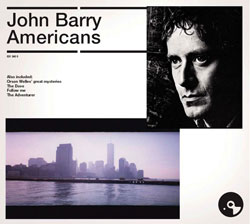 “Americans was a thrilling experience, a record with the concept of an imaginary soundtrack: for the very first time, instead of appearing on a screen, the images came from inside me."
“Americans was a thrilling experience, a record with the concept of an imaginary soundtrack: for the very first time, instead of appearing on a screen, the images came from inside me."
John Barry interviewed by Stéphane Lerouge
October 2, 2009
"My vocation was born in the cinemas my father owned in Yorkshire. Seeing Mickey Mouse in black and white in 1937 was a decisive moment. I was four years old and those five minutes marked me for life. From then on, you couldn't get me out of my father's cinemas: being an assiduous visitor was the basis of my education, both in films and in music. It was the best school I could have had. I was a child and already I was analyzing the relationship between what I could see and what I heard. I'd see the same film up to three times a day with different audiences, and I ended up understanding films from the inside, especially the interplay between music and scenes, point or counterpoint. Films were an extraordinary means of escape from the everyday greyness and the war. They were a way to dream: I travelled to India, Africa and Asia, discovering the world. Not to mention the noir films or the Hollywood musicals: they gave me the impression I was living in the United States." That's how the great John Barry recently explained how he discovered motion pictures... and the power that music has over them. To his film-culture he added a solid, classical education that was thoroughly shaken when he felt the jazz earthquake as a teenager. "My brother Pat was ten years older than I was, and he was a great fan of swing, Ellington, Basie, Hampton and Woody Herman," emphasizes the composer. "He literally devoured everything that came from America. I was immersed in Chopin or Sibelius and I looked down at him; to me, jazz was a sub-language in music. Why would I bother listening to someone blowing into a saxophone when I had Mahler? One day, when I was around fifteen, I started getting interested in the history of jazz and its different styles, and I developed a passion for the modern school: Charlie Parker, Miles Davis, and Gerry Mulligan's Quartet with Chet Baker… What they played came as a revelation: I had to admit that it was another form of expression; it was stupid to create a hierarchy between jazz and the classical repertoire. And so I started playing the trumpet..."
The rest is history. In 1957, the composer formed The John Barry Seven with some old friends he'd known during his military service, all under the influence of Little Richard or Bill Haley. Their popularity grew crescendo and, one thing leading to another, Barry turned to composing for films. Thanks to the cinema, he was able to create a synthesis between the different cultures that had formed his apprenticeship. In no time at all, a series of box-office hits catapulted him into the limelight as a composer for the young and modern: Born Free, The Knack -a film-manifesto for Swinging London- the first James Bond films, and also those featuring the anti-Bond, Michael Caine in the role of Harry Palmer. Millions of film-buffs and music-fans discovered the singular splendour of John Barry's compositions: an unconventional harmonic universe filled with booby-traps, plus a very personal feeling for lyricism, melodies that were instantly catchy, a taste for characteristic, unusual timbres, not to mention the surprises created by his orchestration… Walking a tightrope between the wide-screen spectacular and the filmd'auteur, John Barry is a sophisticated composer whose most visible, most famous scores (say, the action movies, the Bond films) did little to hide a more secret, melancholy vein that tended towards introspection.
In 1975, John Barry was forty-two. He'd been living in Majorca for a year when he accepted an offer to go to Los Angeles and write the music for Eleanor and Franklin, a film made for television by the Canadian director Daniel Petrie, and in October that year he settled in at The Beverly Hills Hotel. His American stay was due to last a few weeks at most; he still lives there today, some thirty-four years later. Barry took advantage of his visit to begin composing a 12" LP that was highly original, containing music "seen" exclusively through his own eyes. "At the time," he remembers, "I was just coming out of an extremely intense period of work. 1974 had been particularly busy: the musical Billy had been staged, first in Manchester and then in London, and it was followed by the films The Dove, The Tamarind Seed and The Man With the Golden Gun. I needed to recharge my batteries, take on a new project that was quite different, like a breath of oxygen. So I went about it the way I usually do: I took notes spontaneously, on instinct, without even thinking about the way to treat them later. It might have been the first bars of a melody, a harmonic sequence or some counterpoint... The idea just came to me; I thought about it, jotted it down and then let it settle... and I took a look at it a few days later to see if it stood up. Put together, the different ideas all took shape as Americans, a personal impression of the sights and sounds of the United States. It was the vision which an Englishman (actually a Northerner) had of the country that had fed his imagination as a youngster. I tried to find the sensations of my first visit again, when I crossed The Atlantic for the first time at the end of the Fifties. Imagine the symbol: me, born in (Old) York, discovering New York! It was a way of confronting my dreams with reality."
In John Barry's career, Americans marks a deliberate pause, a desire to come face to face with his own self, as if he were taking his bearings now that he'd reached his forties. After the hectic pace of the previous fifteen years—a period that included ten films in 1965 alone—this first orchestral album outside the film-world gave Barry the opportunity to regain control over his freedom. "It's perhaps what I love most," he says, smiling. "It's exciting to work with a filmmaker who's touched by your contribution to his work. It's also just as exciting to have the power of decision over your own music... without having to explain it to anyone! (Laughter.) It allows your brain to function differently... Take the famous Yesternight Suite, for example; I conceived and imagined it the way I wanted to, quite freely. In films, I'd never have been allowed to compose a piece lasting seventeen minutes; in fact it's one of the longest I've ever written. It has a vast continuity exploring quite different atmospheres, and it links very contrasting moods. I wrote it first like a synopsis, before I got into the details of the orchestration, and I included quotes from As Times Goes By and By Myself. I didn't want to disconcert listeners too much, just give them the odd hint with standards that were objective... but also integrated into a brand-new original composition. That's a lesson I learned from my father: you must have a feeling for the audience. As an owner of cinemas and theatres, he always used to say: "Make them laugh, make them cry, make them thrill!" That's a caricature of course, but moving from one sentiment to another really is necessary."
Recorded in Hollywood in November 1975, Americans involved some spectacular sessions at Glen Glenn Sound. Facing John Barry were two formations, both of them physical incarnations of his twin cultures: an orchestra of fifty musicians (with first violin Israel Baker), completed by a fiery jazz combo. Barry had summoned some great players: trombonist Dick Nash and trumpeter Tony Terran, not to mention saxophone virtuoso Ronnie Lang, who was later the soloist on Body Heat, another Barry masterpiece. "I adore Ronnie's sound and phrasing," admits the composer. "He played with Les Brown... and Harry James, whose band was a reference in my young days. To me, the timbre of an alto saxophone has deep ties with America's great cities, and New York at night; a suggestion of urban solitude. That's what I tried to convey in the pieces where Ronnie's the soloist, like Social Swing or some parts of the Yesternight Suite. On the other hand, Strip Drive evokes Los Angeles, cruising down the coast at sunset. Speaking Mirrors represents the city-architecture, those forests of tall buildings with towers of glinting glass. Listening to these compositions again, I realise how much I loved working with those sublime musicians. At a pinch, I conducted them like a filmmaker directs his actors. Right from the start, they gave me the nuances I was counting on. They were rivalling with each other, playing together like brothers. Listen to the trombone and saxophone duet on Downtown Walker, for example, a kind of stroll through Manhattan: Nash develops a carefree melody while Lang stubbornly repeats the same phrase in a loop, like a translation of the unceasing movement there is when you're walking. I love that principle: like in Midnight Cowboy, the counterpoint is just as important as the melody..."
Americans was released both in Britain and in Japan, and is now available here for the first time since its original release in autumn 1976. To complete this reissue there are four John Barry titles from the Polydor years, including the theme from Follow me, the film that documented his meeting with veteran director Carol Reed. "He didn't have a musical background but his instinct for film-music compensated for it," remembers Barry. "Without thinking, he knew what would work. Personally, I was extremely flattered and impressed to find myself facing the director of The Third Man; the film left an indelible mark on me when I was a teenager. The theme composed and played on the zither by Anton Karas is a definitive model for obviousness and efficiency... It made me understand that a single instrument with a strange timbre, playing a tiny melody, can have more dramatic impact than a whole flood of orchestras. In a way, it was a lesson I remembered when I was writing the themes for The Persuaders, The Adventurer or Orson Welles’ Great Mysteries. They were meant to instantly catch the viewer's ear, with a heady bass line, scraping harmonies, and a very simple melody played solo on the cimbalom. At the time, I was working with an astounding English musician named John Leach, a real wizard who collected all kinds of ethnic instruments from around the world. John's help was very precious to me: the weird instrumental ideas he brought in allowed me to turn some of my ambitions into reality, particularly the idea of always aiming for a fresh, original, unconventional sound."
In their own way, the ten tracks on this present album act like a portrait of John Barry in the mid-Seventies. Americans, in particular, can be listened to like a permanent firework display, one whose jazz pulse and energy still allow glimpses of an overshadowing lyrical tristesse. A state of grace somewhere between swing and disillusionment… Twenty-three years later, for Decca, Barry would record two more albums outside the world of films, the works of a composer who'd reached maturity: The Beyondness of Things and Eternal Echoes. The colour of those albums is more autumnal, and their inspiration more elegiac, more introspective, too. As if spleen, both in the man and in the artist, had finally gained the upper hand. "You have to remember that the war hit me when I was six," concludes the composer. "It was a traumatic, wrenching experience that made me melancholy for life. It's a side of my personality that I no longer try and hide... So, when I listen to Americans today, I'm both amused and troubled at the same time: it's like going through an old album and finding a photo of me taken in 1975. But it was still a thrilling experience, a record with the concept of an imaginary soundtrack: for the very first time, instead of appearing on a screen, the images came from inside me."
Stéphane Lerouge
Jarvis Cocker’s Meltdown – The Music of John Barry - Royal Festival Hall, London
21/6/2007
Jarvis Cocker’s Meltdown – The Music of John Barry - Royal Festival Hall, London
London Philharmonic Orchestra
- Goldfinger
- We Have All the Time In the World (Sung by Jarvis Cocker)
Other John Barry themes were conducted by Nicholas Dodd.
- Zulu
- Somewhere in Time
- Moviola
- Theme from ‘The Persuaders'!
- Mary, Queen of Scots
- Midnight Cowboy
- Dances With Wolves – Suite: (The John Dunbar Theme / Dawn Attack – Parts 1 & 2 / Kicking Bird’s Gift / Journey to Fort Sedgewick / Two Socks - The Wolf Theme / Farewell & Finale)
- Born Free
- All Time High (From ‘Octopussy’)
- Out of Africa
- Body Heat
- Chaplin
- Space March (From ‘You Only Live Twice’)
- Walkabout
- The Knack
- The James Bond Suite: (The James Bond Theme / From Russia With Love / Thunderball / 007 / You Only Live Twice / O.H.M.S.S. / Diamonds Are Forever
- Encore: The James Bond Theme
Programme submitted by Gareth Bramley.
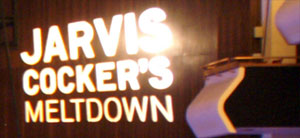
Vic Flick interview
On Universal Exports James Bond fansite.
10 October 2005
Contact the JB site
If you wish to send an email, for example with content for the website, please contact Geoff Leonard:
Email
This email address is being protected from spambots. You need JavaScript enabled to view it.
Location
Bristol, UK
Geoff (owner) and Ruud (webmaster) have been running the John Barry website since June 18, 2001.
This website is not endorsed by the composer's family.
Use of copyrighted materials and logos are for promotional purposes only.
All files on this website are for personal use only and cannot be bought or sold.
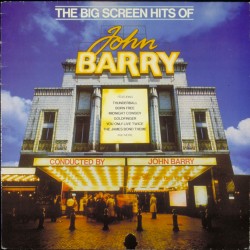
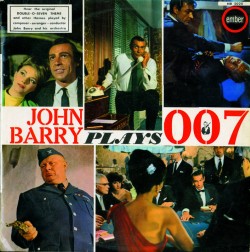
Our other sites
Geoff Leonard writes CD booklet notes, articles, and occasionally books, in partnership with Pete Walker. You can read more about this here:
Some albums
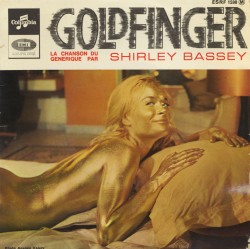
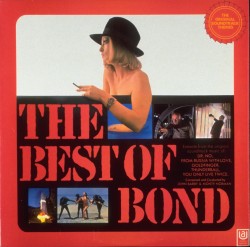
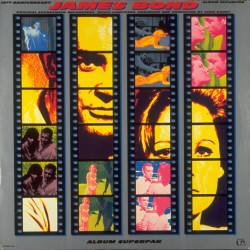
Events or Concerts
Submit your Event or Concert, This email address is being protected from spambots. You need JavaScript enabled to view it. We will not be responsible for any errors or inaccuracies.




